Slacklines are tough. Great exercise for your core, but it takes hours of practice just to get that balance right. We are entering a phase in the market that will be equally tricky for portfolio managers and advisors. On one hand, we will have the Trade Wars and slowing GDP and earnings growth pushing our stocks in one direction. While, on the other hand, we will have the Fed cutting rates pushing our stocks in the opposite direction. It will feel like we are on a tightrope.
Last week the Fed moved closer to cutting the Fed Funds rate in July by issuing a more dovish statement after its regular meeting. You can see it below, or in a word cloud, but these words are prevalent: down, uncertainties, weigh, lower, adverse, risk-management, smaller and below. It is clear from the bulk of data that we see, receive and hear daily that the slowdown is in place. The Fed is looking to try and soften the blow by cutting rates sooner rather than later.
Earnings season will begin this week. Citigroup (NYSE:C) started the banks off today with an uninspiring report (but thanks for the TradeWeb gains!). Plenty of other big banks this week, and over the following two weeks the bulk of major earnings reports will be released. While earnings outlooks have been cut, stocks have instead performed very well and have hit all-time new highs going into the releases. If I am long, I don’t like to see stocks run into the numbers because it sets them up for disappointments. At 17x 2020 estimates, the market seems fully priced, but once again, recall that animal spirits are pushing multiples higher as the Fed tries to guide market interest rates even lower. So, get on that rope or slackline and get balancing because this game is in play.
We knew the Fed meeting and statement would be dovish. Here are some key points…
Important comments from the Fed statement:
• With regard to the outlook for monetary policy beyond this meeting, nearly all participants had revised down their assessment of the appropriate path for the federal funds rate over the projection period in their SEP submissions, and some had marked down their estimates of the longer-run normal level of the funds rate as well.
• Participants widely noted that the global developments that led to the heightened uncertainties about the economic outlook were quite recent. Many judged additional monetary policy accommodation would be warranted in the near term should these recent developments prove to be sustained and continue to weigh on the economic outlook.
• Participants stated a variety of reasons that would call for a lower path of the federal funds rate. Several participants noted that a near-term cut in the target range for the federal funds rate could help cushion the effects of possible future adverse shocks to the economy and, hence, was appropriate policy from a risk-management perspective.
• Several participants pointed out that they had revised down their estimates of the longer-run normal rate of unemployment and, as a result, saw a smaller upward contribution to inflation pressures from tight resource utilization than they had earlier. A few participants were concerned that inflation expectations had already moved below levels consistent with the Committee’s symmetric 2 percent objective and that it was important to provide additional accommodation in the near term to bolster inflation expectations.
We had some hot CPI data last week, but you have to agree with Tim Duy that it won’t be enough to keep them from cutting rates at the next meeting…
CPI data revealed firmer inflation in June. Pulled higher by apparel and used car and truck prices, core CPI rose 0.3%, its fastest monthly pace since January 2018. June PPI grew at a faster than expected pace, but the headline number was up just 0.1% while PPI excluding food, energy and trade services was flat after more rapid increases of 0.4% in both April and May. It would be tempting to conclude that the firm CPI inflation number in particular would soften the Fed’s resolve to cut rates, but it’s so far just one month and the Fed is more concerned about the possibility that weak growth going forward will weigh on future inflation. The Fed has shifted toward caring less about the threat of higher inflation and more about actual inflation; it will take more than one month for actual inflation to become interesting.
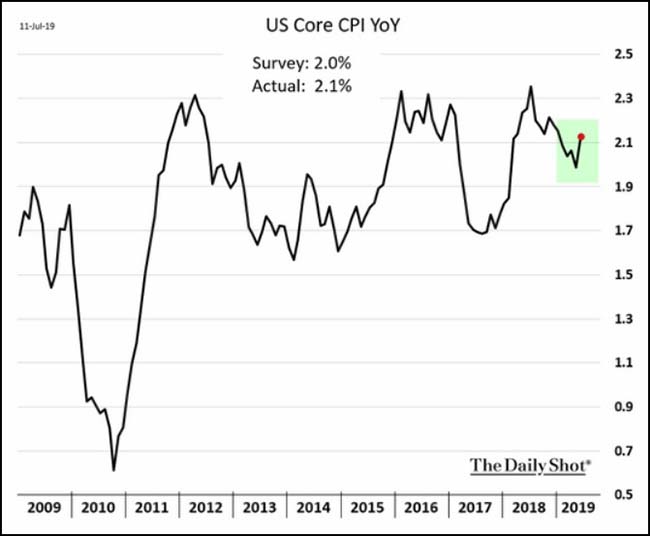
One of the more interesting series within the CPI is the continued gain in housing costs…
A very tough time for the kids who have not bought a house and are renting. It has been a long wait for prices to decline in order for them to jump into the purchase market. Of course, great news for owners of multi-family apartments.
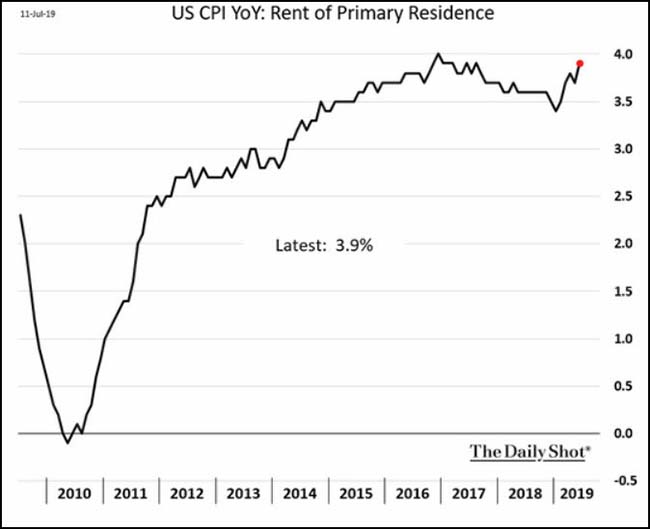
IPO outperformance by this degree would usually lead the Fed to talk about irrational exuberance…
Just shows how aggressive the stock market has become if the Fed is now talking about cutting rates instead.

If you need another sign of exuberance…
@NoonSixCap: YETI sold $1mm worth of fancy dog bowls in Q1

Back in the real big world of commerce, railroad volumes are slowing down every week…
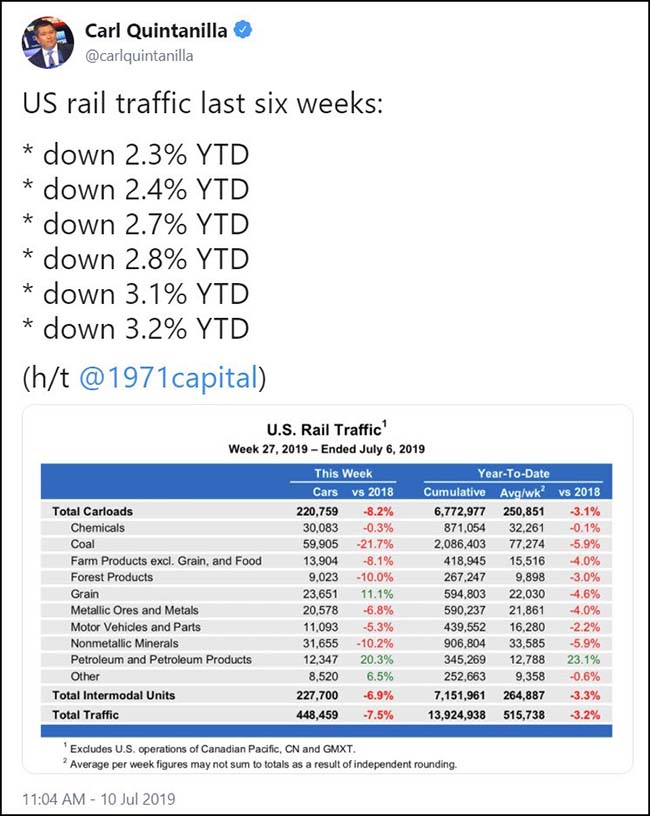
And forward plans for Capex are also slowing which will impact future GDP…

Slowing Capex guidance explains why hiring is also slowing down…
@danielbzhao: May #JOLTS report out this morning from BLS shows job openings at 7.3M (NYSE:MMM), with growth from 2018 slowing substantially in 2019, consistent with @Glassdoor data. Our June data shows a similar trend, so don’t expect a reversal any time soon. The labor market is healthy but slowing.
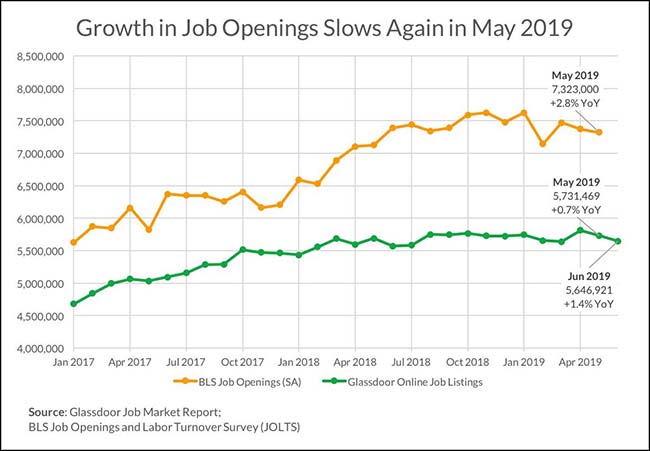
The Leuthold Group had a good summary of Recession Watch charts to follow…
@LeutholdGroup: How much is enough #recession evidence? Positive #GDP Output Gap, inverted #YieldCurve, early-cyclicals’ harsh underperformance, faltering (?) housing & autos, sharp decline in industrial commodity prices, business & consumer confidence teetering.

So with all the slowing data, there should be less upside sales beats as corporate earnings hit the tape…
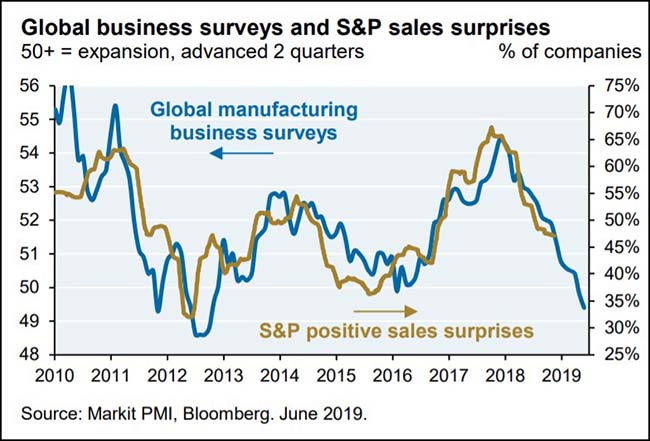
Here is a good list of the companies reporting this week. Many big names across the economy…

One of the world’s largest chemical companies gave us a preview of the global issues that are negatively affecting their current sales and earnings…
On Monday, German chemicals giant BASF warned of a slew of issues that took a toll on its second-quarter results, including slowing auto sales and North American farming woes. The concerns it raised are hardly unique to BASF. Many can be traced back to trade tensions.
BASF released preliminary figures showing that earnings before interest, taxes, and other special items likely fell by nearly 50% in the second quarter. Global auto production declined by around 6% in the first half of 2019, the company said. Production in China, the world’s largest market, fell by more than twice as much. The country’s auto market is being hit by some specific regulatory issues, but also a broad weakening in consumer sentiment as trade tensions threaten the economy.
The company’s agriculture business was weak, too, partly due to weather conditions that made for a rough planting season in North America. But the tenuous relationship between the U.S. and China, a large buyer of U.S. soybeans, have hit farmers, too.
Tech stocks are also in for a change in sales and earnings composition as the big internet companies were removed from their sector…
Technology stocks appear particularly vulnerable to a drop in earnings. Analysts estimate earnings per share at tech companies will shrink by just over 7 per cent on average compared to the second quarter last year, tying with materials as the worst sector by earnings growth forecasts, according to Credit Suisse (SIX:CSGN).
The tech sector — which, after an index reshuffle, no longer includes social media groups such as Facebook (NASDAQ:FB) and Google’s parent company Alphabet (NASDAQ:GOOGL) and is instead dominated by hardware companies — is suffering a squeeze on its profits due to a tightening labour market, according to Goldman Sachs (NYSE:GS). Labour costs amount to about 16 per cent of revenues for the information technology companies, the second highest level after the industrials sector, according to the bank.

Germany on its way to becoming debt free?
The country has issues but is doing things right by paying down debt while times are good. Other debt-laden countries should take note.
Germany has just sold €3.2bn of new 10-year bonds at a negative yield: the latest demonstration that investors are prepared to pay for the privilege of lending to Europe’s largest economy.
But despite the red-hot demand for its debt, Berlin is resisting any temptation to go on a borrowing spree. Quite the opposite. Germany’s finance agency announced in April that its ratio of debt to gross domestic product would this year drop below 60 per cent — a sharp decline from more than 80 per cent as recently as 2012, meaning that Germany is the first big EU economy to meet the Maastricht guidelines on public debt since the financial crisis.
Rather than saluting this Teutonic restraint, some investors are raising concerns that the country’s dwindling debt pile is actually a problem. Bunds — as German bonds are known — are the eurozone’s benchmark safe asset. If there are not enough of them around, banks could run short of high-quality collateral for lending, while the European Central Bank will struggle to find enough bonds to buy if it wants to revive its quantitative easing programme to combat a downturn.
As a result, check out Germany’s interest cost…
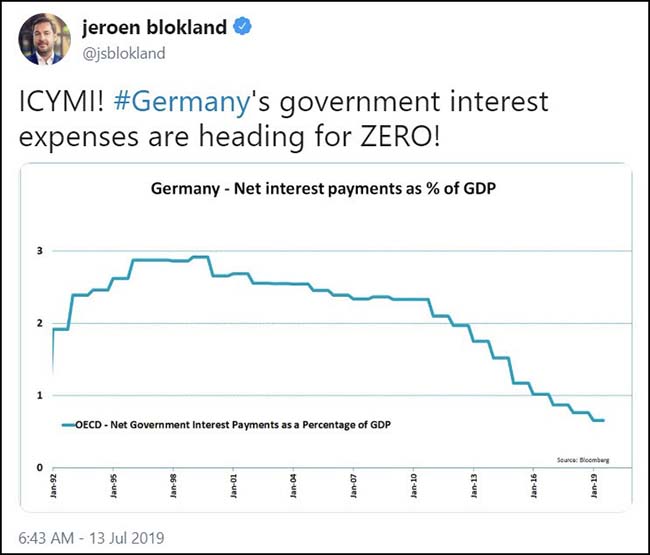
Colorado mortgage pools and housing assets looking to trade at premiums…
Buying a house on the water? By the time your 30-year mortgage expires, you could be facing between 25 and 135 days of high-tide flooding, depending on where you live.
That’s the message from the National Oceanic and Atmospheric Administration in a report that says rising seas spurred by climate change will put waterfront U.S. cities at risk for 25 to 75 days of high-tide flooding by 2050. There were 10 days last year on average in the Northeast, with the city of Washington having 22 days, the study released Wednesday said.
Some regions, meanwhile, will see even greater increases, according to William Sweet, a NOAA oceanographer and the report’s lead author. High-tide flooding, also called “sunny day flooding,” occurs even without storms, largely driven by rising ocean levels, he said.
“The New York City region, which had about 12 days of high-tide flooding in 2018, will experience somewhere between 55 to 135 days” on average in 2050, Sweet said on a conference call with reporters. “The current trajectory suggests, let’s say, a floodier future.”
My book recommendation last week created lots of talk about sleep…
This future baseball Hall of Famer has some strong thoughts that we should all listen to.
It was early May 2018 and Alex Bregman, the Houston Astros’ star third baseman, had only one home run on the season. His teammate Justin Verlander, one of the best pitchers of this generation, noticed Bregman’s low power and hints of fatigue, and asked how many hours Bregman had slept the night before.
Six, Bregman answered. And his normal amount? Six, as well.
The responses bewildered Verlander. He promptly told Bregman, 25, that he slept at least 10 hours a night and said Bregman should start getting more hours himself.
“I felt like that’s overdoing it,” Bregman said. “You shouldn’t sleep that much.
“Then I started sleeping that much and, next thing you know, I hit 30 homers after that.”
